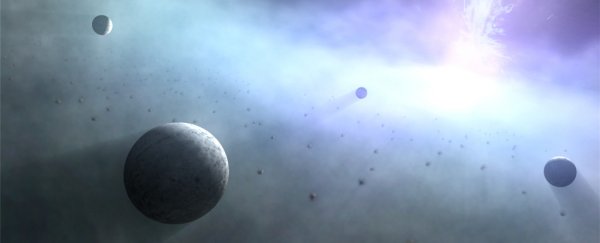It's easy to think of black holes as voracious destruction machines, slurping up everything in their immediate vicinity. But that's not always the case. The environments around active supermassive black holes are complex, and last year, a team of astronomers showed that there's a safe zone around each supermassive black hole in which thousands of planets could be orbiting.
Now, the team led by Keiichi Wada of Kagoshima University in Japan has given a new name to these black hole planets - "blanets", which is just delightful - and worked out how these blanets might form from the grains of dust swirling around the black hole.
"Here, we investigate the dust coagulation processes and physical conditions of the blanet formation," they wrote in a paper currently submitted to The Astrophysical Journal for peer review, and uploaded to the pre-print service arXiv.
"Our results suggest that blanets could be formed around relatively low-luminosity active galactic nuclei during their lifetime."
We know that stars can be captured in orbit around supermassive black holes - astronomers have been observing the complex dance of stars around Sagittarius A*, the supermassive black hole at the heart of the Milky Way, for decades.
It's also been hypothesised that exoplanets - both orbiting those captured stars, or rogue - can be captured by black holes, too.
But Wada's team proposes a new class of exoplanets, those that form directly around active supermassive black holes at the hearts of galaxies. Such an active black hole is surrounded by an accretion disc, a huge torus of dust and gas swirling around, its inner rim feeding into the black hole.
This is a lot like how planets form around stars. A clump in a gas cloud gravitationally collapses in on itself, spinning; this is the protostar. As it spins, material from the surrounding cloud forms a disc that feeds into it, while a little farther away from the star, where the material is orbiting more stably, planets can form.
In the planetary formation process, the grains of dust that make up the disc start to cling together due to electrostatic forces. These larger pieces then start to collide with each other, gradually accumulating more and more grains until the object is massive enough for gravitational forces to take over. If nothing disrupts the process, after a few million years or so, you have a planet.
In their paper last year, Wada and his team found that, at sufficient distances from the black hole, blanet formation may be even more efficient than around stars, because the orbital velocity of the accretion disc is fast enough to keep the objects from escaping orbit and drifting towards the black hole.
But there were some problems with their calculations. Firstly, it's possible that, if the collisional velocity of the gas clumps is high enough, the initial dust aggregates could smash each other apart, instead of sticking together. Secondly, the clumps could grow very rapidly at the collisional stage, which does not fit a more natural dust density model.
With these constraints in mind, the team recalculated their blanet formation model outside the 'snowline', the distance from the central body at which volatile compounds can condense into ice. And they found that, if our planetary formation model is correct, there should indeed be conditions under which blanets can form.
If the viscosity of the disc is below a certain threshold, that will prevent the aggregates from destroying each other on collision. And, because the formation of blanets is not subject to the same limitations as planets, they can be absolute chonkers.
Around a supermassive black hole clocking in at 1 million solar masses, blanets at the snow line could form in 70-80 million years. The farther they are from the black hole, the bigger they grow. According to the team's new calculations, at around 13 light-years from the black hole, blanets could range between 20 and 3,000 Earth masses, which is right at the upper limit for planetary mass as we know it.
For a black hole at 10 million solar masses, this mass can easily tip over into brown dwarf territory: bodies that are between gas giants and stars, fusing deuterium in their cores, but not quite massive enough for hydrogen fusion.
Of course, we can't actually detect these objects, which means they have to remain purely hypothetical for now. But they have joined a growing coterie of adorably named hypothetical cosmic objects, which includes moonmoons (moons of moons) and ploonets (the moons of large exoplanets that get kicked out of planetary orbit into stellar orbit, like a planet).
And, the researchers note, blanets open up interesting avenues for exploring the extreme space around supermassive black holes.
"Our results suggest that blanets could be formed around relatively low-luminosity active galactic nuclei during their lifetime (100 million years)," they wrote in their paper.
"The gaseous envelope of a blanet should be negligibly small compared with the blanet mass. Therefore, the system of blanets are extraordinarily different from the standard Earth-type planets in the exoplanet systems. The dynamical stability of such a system around a supermassive black hole may be an interesting subject for future studies."
The research has been submitted to The Astrophysical Journal and is available on arXiv.
